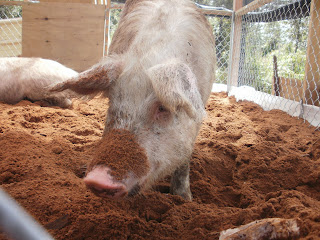I'll get into the details of building the piggery barn later, but thought I'd take take the opportunity of a rainy morning to share with you how we filled the pens themselves. It's an interesting process.
One must first construct a pen in order to fill it.

We used cinders to fill in the corners up to the tin sidewalls, then the pen was lined with a woven geotextile plastic groundcover-like fabric. This is to keep the rocks and cinder from puncturing the actual liner, which is a thick woven polyethylene waterproof material. Using a waterproof liner like this is not part of the CGNF method. Ideally there would be direct contact with the soil. However in the US, there is great concern over groundwater pollution, so hoops must be jumped through. Our piggery is the pilot project for using something other than concrete to line a deep litter system. If this works, and we have no doubt it will, then it will open up a less-expensive alternative for backyard farmers. All this has come about with the help of Mike DuPonte from the University of Hawaii-Hilo Agriculture Extension Department.
On a fine early February morning, several folks from our local Natural Farming group came by to help with filling the pen, and to learn how to create the various layers needed for the microbes to thrive. Very hands-on and always more fun with friends to help!
First, we spread 3-4 inches of red Hamakua cinder-soil, and topped that with 1 cubic foot of biochar.
On this base we placed an assortment of logs, gleaned off our property. Most of them were albezia and secropia, but there were a few ohia and others in there as well. The logs ranged from 6 inches to 1 foot in diameter.
With our chipper/shredder we had prepared wood chips from the smaller branches and coconut husks to use for filling in around the logs. These went in next, with palm fronds laid over the top. Now we have created long-lasting food and air spaces for the microbes and beneficial bacteria to live. This is important for cutting down the smell one usually associates with pig farming.
Atop this mass of plant material, we added 9 tractor-scoops of sawdust to each 1 scoop of cinder soil. The sawdust came from a local mill and is made of tropical hardwoods, but of course you would use whatever local resource you have. Each layer got sprinkled with IMO4 and sea salt, according to Master Cho's formula. We did several layers like this to fill the pen, raking out between scoops to keep it nicely leveled.
A week later, we added about 1 pound of dolomite and more IMO4. Each week for the next 3 months, we sprayed the floor with 1 gallon water to which had been added 1 teaspoon FPJ (fermented plant juice) and 1 teaspoon LAB (lactic acid bacteria) and more IMO4.
The pigs were acquired and introduced to their new home in mid-February. Ideally, the pen would have had a bit longer to ferment before the animals would be introduced, but you work with what you've got. These young gilts were raised on concrete and had never been on real dirt. They were reluctant to leave their travel cage at first, but with only a little gentle coaxing, they soon meandered into their prepared pen, and then they were indeed in hog heaven! The very first thing they did was to root their way across the whole pen and plop down with a sigh of contentment. Tails wagging, grunts of happiness, rooting for the first time in their lives!



The only problem we've noticed is that the decomposing sawdust creates quite a bit of heat. This would be ideal in a cooler climate, but for the tropics and at this low elevation (400'), we would use woodchips rather than sawdust next time. This will slow the decomposition, thereby creating less heat for the pigs. To counteract this, we have installed a mist system that gets turned on during hot days. The fine mist spray seems to really help the sows keep their cool.
Pen maintenance is easy. We rake the floor smooth every morning while the pigs are feeding. For a while, more IMO4 was sprinkled weekly over the fresh manure to help it break down more quickly. This is no longer needed because there is enough microbial and fungal life in the pen to do the job.
That's it! No smell, very few flies. Contented, happy, healthy pigs. That's what it's all about.




































